Data Analysis and Statistics of Dog Rescuing in Scotland
Understanding the plight, and myth busting - Colin Gray
(Rescue Scottish Pets) 13/02/2014
Download PDF Version
Introduction
Rescue Scottish Pets is a website that was set up in November 2010. Its primary aims are:
· To raise awareness of pets in need of rescue all over Scotland.
· To provide one place where people looking to rescue a pet can come to find those pets in need.
· To provide a place where shelters can easily advertise pets in need and their cause at no cost, and requiring very little effort or computing expertise.
Since its inception, 30 Scottish registered charities have joined the website. These charities have listed a total of 2884 animals in need of rescue, of which 2552 were dogs. This reports aim to analyse the statistics of these dogs to build up a picture of dog rescuing in Scotland, but also to analyse some conceptions that are commonly held. The key questions and conceptions this report aims to analyse and hopefully provide some evidence for or against are:
1. How many dogs are in rescue, what are their statistics, and how many are listed per month?
2. Which breeds are most commonly found in need of rescue?
3. How long does it take for a dog to be rescued, and is this breed specific?
4. Rescues are filled with crossbreeds, not pedigrees. Is this commonly held belief true?
5. Rescue dogs are often problem dogs. Is this commonly held belief true?
Data Used
The source of data for this report is the dogs listed on the Rescue Scottish Pets website. Given Rescue Scottish Pets currently has 24 registered charities that rehome dogs, of which 14 are breed specific and the remaining 10 are not breed specific, it provides a good spread of different charities, regions and breeds in Scotland. However it should be noted that Rescue Scottish Pets focussed on smaller charities initially (to help raise awareness of their cause and dogs), and required the charity to opt-in, therefore there are charities in Scotland whose data is not present in this analysis. It should also be noted that not all of the registered charities list all of their dogs; some only list the dogs most in need. However given Rescue Scottish Pets is in an unusual and likely unique position of having data from many charities, and that it is likely to be impossible to gather all data on dogs in rescues nationally, this author feels this provides a good representative sample of dogs in Scottish rescue centres or foster care upon which to base a report.
Dogs in Rescue – Numbers and breeds
As previously stated a total of 2552 dogs have been listed on Rescue Scottish Pets for rescue. This means an average of 66 dogs per month have been listed in need of rescue. Given the data, as previously stated, is likely just to represent just a fraction of the total dogs in need in charities across Scotland, this is a significant amount of dogs. If we then compare the number of dogs listed in 2013 until the date of writing (922 dogs), and compare this to those marked as being rehomed in the same time period (877 dogs), not surprisingly we see the number of dogs listed outweighs those being rehomed. In other words for every dog rehomed, at least one new dog is listed. This highlights the importance and need for people to rescue rather than buying from breeders to help alleviate the rescue situation in Scotland. It is worth noting that not all dogs marked as rehomed actually were. Sadly some of these dogs may have passed away, or been put to sleep for medical reasons. It is not possible from the data available to determine how often this is the case (although it is expected to be a very small number).
Of these dogs listed, what breeds were the most common? Below are two charts showing the number of dogs and the breed they were listed as.
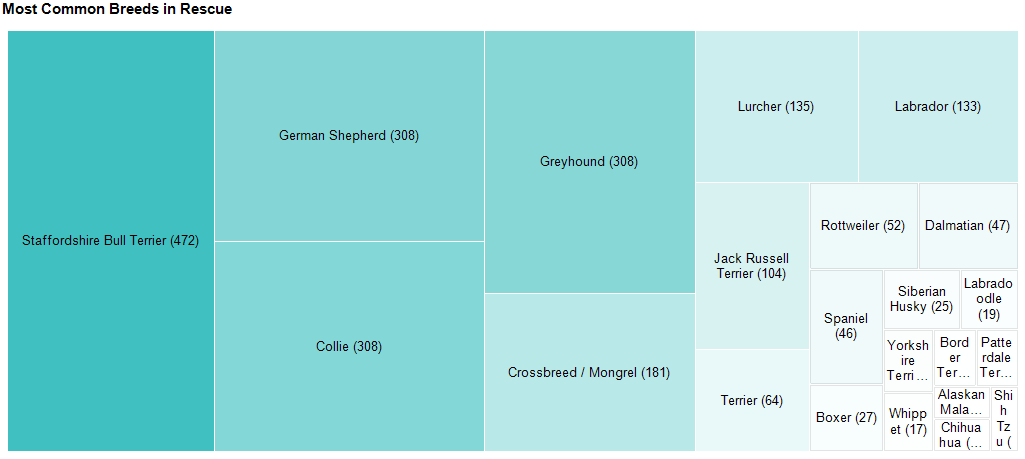
Figure
1 – Treemap of the top 20 most common breeds of dogs listed for rescue. The
larger the area the more common the breed
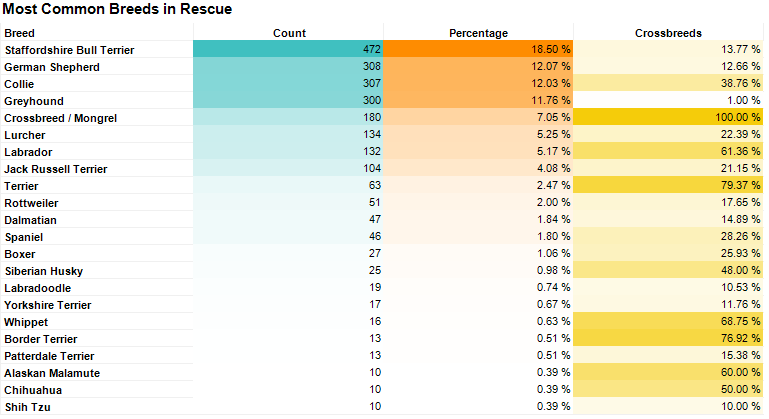
Figure
2 – Statistics of the top 20 most common breeds of dogs listed for rescue.
It can clearly be seen that 4 particular breeds of dog dominate those in rescue with 1387 or 54% of all dogs listed for rescue being one of; Staffordshire Bull Terrier, German Shepherd, Greyhound or Collie. Of particular note is the plight of the Staffordshire Bull Terrier representing 18.5% of all dogs in rescue.
Overall the foregoing charts display the large variety of breeds found in need of the care of charities across Scotland. In total ~120 different breeds have been listed on Rescue Scottish Pets somewhat dispelling the myth that rescues only have the most common breeds and very little variety. However given the lower numbers of unusual breeds, any prospective rescuer should expect to be patient if they have a specific rarer breed in mind.
Note that some breeds have been grouped together. For instance spaniels have been grouped together i.e. springer, cocker etc are counted as spaniel rather than the individual types of spaniel. The same is true of collies. For the statistics shown any crosses are counted as the first breed listed i.e. a Staffordshire Bull Terrier cross Collie is counted as Staffordshire Bull Terrier for the statistics shown above.
To Pedigree or not to Pedigree – Number of crossbreeds and mongrels
Another commonly held conception is that rescues are filled with crossbreeds and mongrels, and for a pedigree one must approach a breeder. Of the 2552 dogs on Rescue Scottish Pets, 70% of dogs were listed as pedigrees as shown in the chart below:
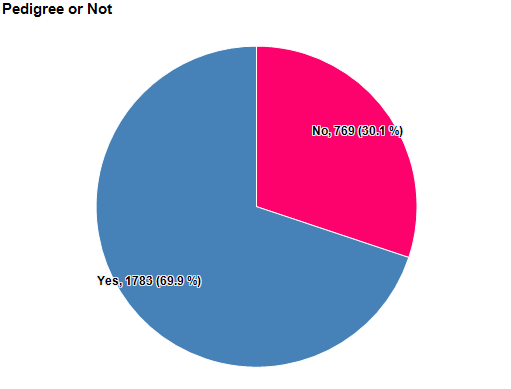
Figure 3 –
Count and percentage of dogs which are pedigrees or not.
This signicant percentage completely dispels the myth that rescues do not have pedigrees for rescue.
Girls or Boys Who Play Well With Others
The other information besides breed that is collected on dogs is which gender they are, and also whether they are good with children, good with other dogs and good with other pets. Of course, with the exception of gender, these traits can be rather subjective. However given all dogs on Rescue Scottish Pets should have been fully assessed and the great experience Scottish charities tend to have, this author can’t think of a better judge of dog character than the charities themselves. Certainly when compared to a breeder who is likely to be unable to properly asses character owing to the young age of the dogs, nor carefully assess who they are selling to (through the use of home checks for instance), one is more likely to get a good match when rescuing rather than buying.
From an analysis of gender of dog listed, it can be seen from the chart below that there is a tendency towards male dogs requiring rescue with 59% of rescue dogs being male.
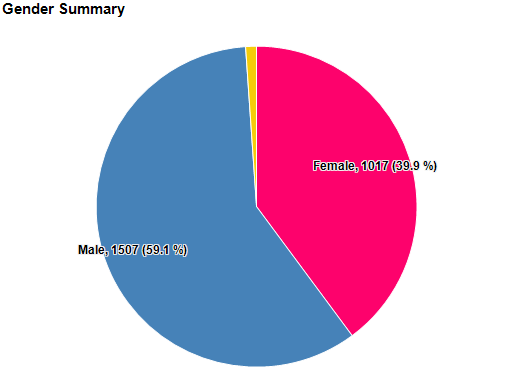
Figure 4 –
Count and percentage of gender of listed dogs. The yellow bar signifies where
two dogs were listed together of both genders.
In the Dog Kennel
Another commonly held belief is that dogs are in rescues because they have problems or issues with behaviour. To test this theory, below is an analysis of the three behavioural pieces of data collected on Rescue Scottish Pets; good with children, good with other dogs and good with other pets.
From the data in Rescue Scottish Pets it was found that of all the dogs listed 51% were listed as good with children, only 7% of dogs were not suitable around children and the rest it was not known or specified:
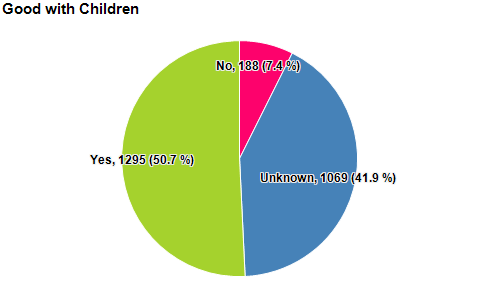
Figure 5 –
Count and percentage of dogs listed as being good with children.
It was also found that 60% of dogs listed were good with other dogs; only 9% were not with 31% it was not known or was not specified:
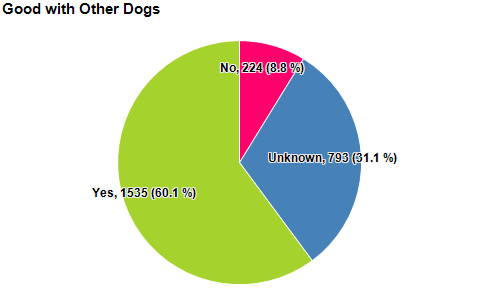
Figure 6 –
Count and percentage of dogs listed as being good with other dogs.
Finally whether a dog is good with other pets i.e. cats, there is less known with 66% being listed as not known or not specified, 18% not good with other pets, and 17% are good with other pets:

Figure 7 –
Count and percentage of dogs listed as being good with other pets.
In summary, based upon the data shown, if there is a perception that most dogs in rescues are problem dogs with behavioural issues, then this is not true. In fact these dogs have often simply been abandoned or given up by their owners, most likely related to the owner and their circumstances, rather than the behaviour of the dog.
Take Me Home – How long do dogs spend in rescue?
In July 2012, Rescue Scottish Pets started to collect the dates that a dog was marked as being rehomed. This data has been used to analyse the length of time dogs spend in rescue before being rehomed. There are however some limitations to the accuracy of this data. The date when a dog is marked as rehomed is based upon when the charity logged into Rescue Scottish Pets and marked that dog as rehomed. Therefore it may not accurately represent the actual day it was rehomed. However it can be assumed that this data represents the maximum time it could have taken to rehome that dog. Weekly update emails are sent to rescues to update their pets so the data on how long a dog took to be rehomed has been described in weeks:
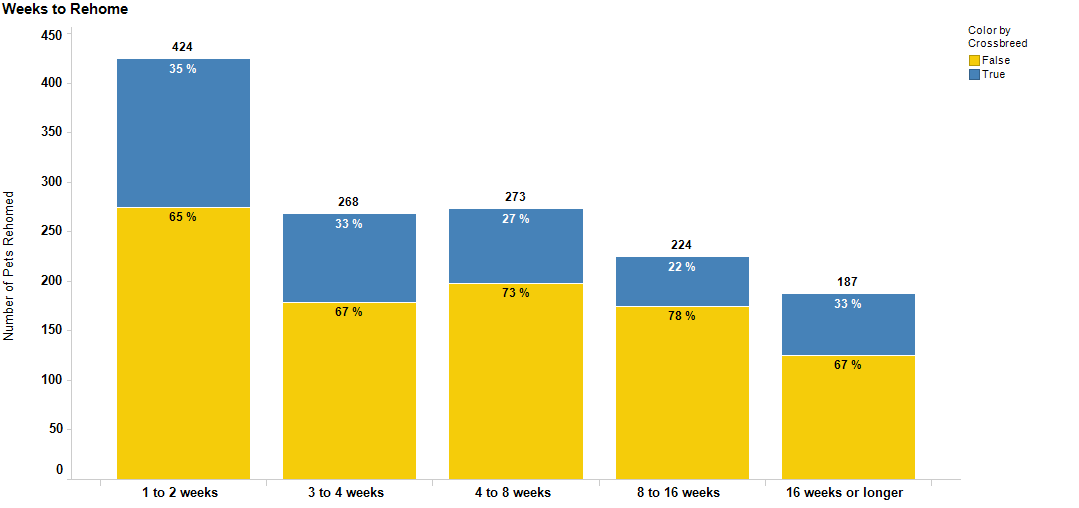
Figure 8 – Summary of how many weeks
it took to rehome a dog.
It can be seen that 50% of dogs are rehomed within ~ 1 month of being listed on Rescue Scottish Pets, with 692 out of 1373 dogs rehomed within 4 weeks and of these, 424 within 1 to 2 weeks. However there are clearly many dogs that are in rescue for longer than a month with 187 dogs taking 16 weeks (~4 months) or longer to be marked as rehomed.
The next question this raises is are there differences between breeds and length of time to be rescued? The chart below displays this for the top 20 breed listed on Rescue Scottish Pets:
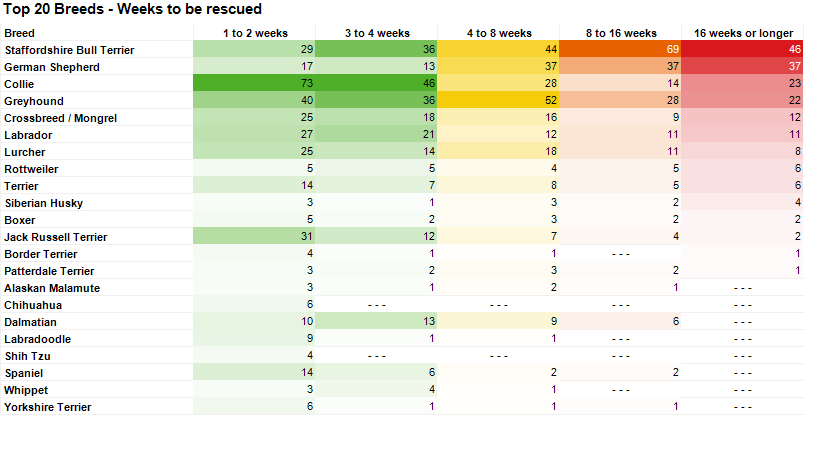
Figure 9 –
Summary of how many weeks it took to rehome the top 20 breeds.
This chart again highlights the plight of the Staffordshire Bull Terrier but also that of the German Shepherd, and to a lesser extent Greyhounds, as they all tend to take over a month to rehome. Other common breeds in rescues such as Collies seem to get rehomed more quickly, with nearly 65% being rehomed within a month and in particular, Jack Russell Terriers tend to get rehomed quickly. Again popular breeds such as Spaniels and Labradoodles are rehomed quickly. From this it can be concluded that particular breeds are harder to rehome and that 3 of the 4 most common dogs in rescue, tend to be in rescue for longer periods. Is this down to the fact that due to their being more of these breeds in rescue, it is harder to find them homes, or could it be that there are more in rescue due to the commonality of these particular being abandoned, given up and/or abused? Most likely it is a combination of both. It is also worth noting the time and expense that is required to care for these dogs while in the care of a rescue. Given the dog will need fed, medical requirements satisfied, a person’s time to care for and walk the dog etc., we begin to understand why charities need the support of the general public to continue to provide this service for the dogs abandoned.
Summary
From the analysis presented it is clear to see that the work for dog charities to do is great. With over 2500 dogs that have been listed for rescue alone on Rescue Scottish Pets since November 2010, not even considering the large number of dogs that are not added to Rescue Scottish Pets, the numbers of dogs in need of rescuing is ever increasing. There are clear patterns in the breeds most affected by this with Staffordshire Bull Terriers most in need, accounting for over 18% of dogs listed for rescue. Other breeds which are often found in high numbers in need of rescue are Collie types, German Shepherds and Greyhounds. It also seems with the exception of Collies, these 3 breeds of dogs take longer than other breeds to rehome. In terms of rehoming overall, 50% of dogs took 4 weeks or less to rehome, and 50% 4 weeks or more. Of the dogs taking longer, 16% took 8 to 16 weeks to rehome, and 14% taking 16 weeks or longer.
In general it was also found that 70% of dogs listed were in fact pedigrees therefore disproving the idea that rescue dogs are most often crossbreeds or mongrels. It is clear from the creation of new breeds which are in fact just crossbreeds (such as Labradoodles, Spanadors, Jugs etc), people, for better or worse, desire pedigree dogs. Ruling out rescues on this basis is therefore not valid.
While there are no doubt some troubled dogs in rescue, the data presented suggests that by in large the dogs listed are often good with children (only 7% listed as not good with children and 51% that are), good with other dogs (60% are listed as good with dogs), but it is often not listed or known how they are with other pets. The question therefore arises as to why these dogs end up in the care of charities? For this one must examine the purchasing habits and subsequent reason why the dogs were given up, as opposed to simply assuming these dogs must be problem animals, as the evidence presented here would seem to refute this claim.
In summary it is hoped that from the data presented not only will it raise awareness of the plights of dogs, and the charities who work to support and rehome these abandoned dogs, but also to make people think about first approaching a rescue before buying from a breeder. Given the fact that charities will often home check, will assess a dog before rehoming it and try and match dogs to the right people and families, it would be this author’s recommendation that only charities are allowed to find homes for dogs, rescue or not. This would lead to the scenario where finding an ideal home and family for a dog would be the primary driver, rather than monetary gain.
It is also clear from the sheer number of dogs in rescue and the length of time it can take to find a new home for them, that charities in Scotland need our support to continue this work. It costs the charities a great deal of time and money to care for these dogs that, from the data presented in this report, are in rescue most likely through no fault of their own.
Annex I - Further Work
This analysis was aimed at providing a simple start to looking at the statistics behind dogs in rescues in Scotland. However more complex statistical methods were used to test the difference in number of weeks to be rehomed for the top 20 breeds, where it was found that (using the Chi Square test) there was a statistically significant difference between breeds. However it was felt by this author that this level of detail and complexity for other areas of analysis would not benefit this report, but may warrant future research (particularly when more data was available).
Other work which was not included was an analysis of months in which dogs were listed as needing rehomed, and were actually rehomed. Another common issue with rescue dogs is the age of dogs. Again this analysis was not done as the data gathered on dog ages is incomplete and difficult to interpret as it is often listed as a range, rather than a definitive age. Also not included was a regional analysis i.e. in which areas in Scotland are dogs listed, do certain areas have more rescues, easier to rehome etc.? This is due to the fact that the majority of smaller charities use a foster network to care for dogs before rehoming and the data is not always collected on where they are being fostered, but it is also not collected on where the dog was rehomed to. This therefore renders this analysis impossible at the current time. It is known that through Rescue Scottish Pets, charities in the North for instance, have now been able to rehome in central Scotland as the awareness of dogs all over Scotland has been raised.
This report also did not attempt to quantify the cost associated with each dog i.e. if we estimated a cost per week per dog, how much would dogs in rescue cost, given the average time to rehome. Further research would be required for this as Rescue Scottish Pets holds no cost data.
Annex II – All Breeds Found on Rescue Scottish Pets
Below is a list of all the breeds ever found on Rescue Scottish Pets website:
|
Airedale Terrier |
Dalmatian |
Kelpie |
Schnauzer |
|
Akita |
Kerry Blue Terrier |
Scottie |
|
|
Alaskan Malamute |
Deerhound |
Labradoodle |
Scottish Terrier |
|
American Bulldog |
Doberman |
Labrador |
See Description |
|
Australian Kelpie |
English Bull Terrier |
Lakeland Terrier |
Shar-Pei |
|
Basset Hound |
English Bulldog |
Leonberger |
Shih Tzu |
|
Beagle |
English Pointer |
Lhasa Apso |
Siberian Husky |
|
Bedlington Terrier |
French Bulldog |
Lurcher |
Small German Shepherd |
|
Bernese Mountain Dog |
Flat Coated Retriever |
Lurchers |
Spanador |
|
Bichon Frise |
Fox Terrier |
Mastiff |
Spaniel |
|
Blenheim Cavalier Spaniel |
Foxhound |
Miniature Poodle |
Sprollie |
|
Bloodhound |
German Shepherd |
Miniature Schnauzer |
St. Bernard |
|
Border Terrier |
German Shepherd Malamute |
Miniature Smooth Dachshund |
Staffordshire Bull Terrier |
|
Boxer |
German Wirehaired Pointer |
Miortic Shepherd |
Standard Poodle |
|
Bull Mastiff |
Giant Schnauzer |
Mongrel |
Standard Schnauzer |
|
Bull Terrier |
Golden Retriever |
Newfoundland |
Terrier |
|
Bulldog |
Great Dane |
Northern Inuit |
Weimaraner |
|
Cairn Terrier |
Greyhound |
Old Tyme Bulldog |
West Highland Terrier (Westie) |
|
Carpathian |
Greyhounds |
Papillon |
Wheaton Terrier |
|
Cavalier King Charles Spaniel |
Hungarian Vizla |
Parson Jack Russell |
Whippet |
|
Chesapeake Retriever |
Huntaway Collie |
Parsons Jack Russell |
Wire Haired Pointer |
|
Chihuahua |
Husky |
Patterdale Terrier |
Working Cocker |
|
Chihuahua (Short Hair) |
Irish Setter |
Pembroke Welsh Corgi |
Yorkshire Terrier |
|
Chinese Crested |
Irish Terrier |
Pharaoh Hound |
Pugachoo |
|
Chinese Crested Powderpuff |
Jack Russell |
Plummer Terrier |
Puggle |
|
Chow chow |
Jack Russell Terrier |
Podenco Andaluz |
Red Setter |
|
Chug |
Jackadoodle |
Pointer |
Red Setters |
|
Collie |
Japanese Akita |
Pomeranian |
Retriever |
|
Corgi |
Japanese Spitz |
Poodle |
Rhodesian Ridgeback |
|
Crossbreed |
Johnson American Bullmastiff |
Portugese Podengo Pequeno |
Rottweiler |
|
Crossbreeds |
Jug |
Samoyed |
Saluki |